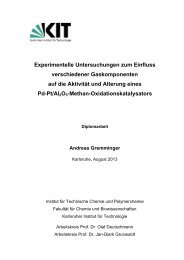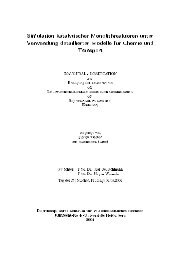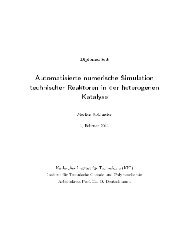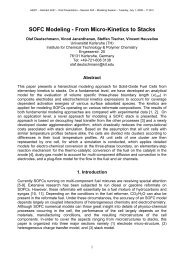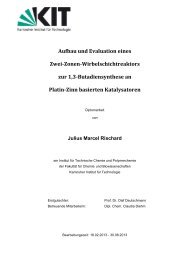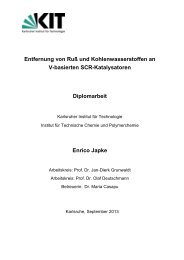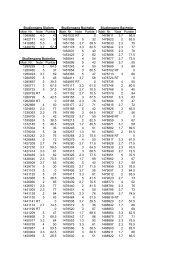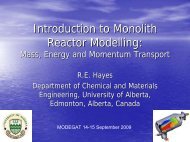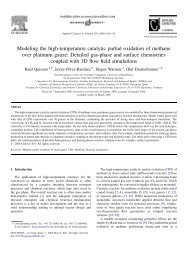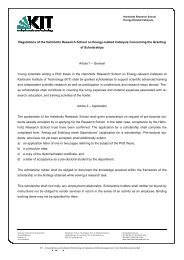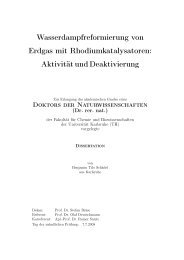Fuel Processing for Fuel Cells - Institut für Technische Chemie und ...
Fuel Processing for Fuel Cells - Institut für Technische Chemie und ...
Fuel Processing for Fuel Cells - Institut für Technische Chemie und ...
Create successful ePaper yourself
Turn your PDF publications into a flip-book with our unique Google optimized e-Paper software.
Author's personal copy<br />
<strong>Fuel</strong> <strong>Processing</strong> <strong>for</strong> <strong>Fuel</strong> <strong>Cells</strong> 55<br />
ambience is smaller <strong>for</strong> higher flow rates (Figure 18). However, the heat<br />
loss effect clearly overlaps with the flow rate effect. At low flow rates,<br />
more exterior channels of the monolith experience much lower temperatures<br />
than at high flow rates and, consequently, hydrogen production is<br />
reduced. In addition to SR, the exothermic WGS reaction also leads to<br />
hydrogen production; this effect is rather small but still has some impact<br />
on the final product composition and catalyst outlet temperature<br />
(Hartmann et al., 2011). In summary, an <strong>und</strong>erstanding of the dependence<br />
of hydrogen selectivity on the flow rate can only be achieved by taking<br />
mass and heat transfer as well as detailed kinetic schemes (reaction pathways)<br />
into account.<br />
7.4 Understanding the dynamics of catalytic monoliths—CPOX<br />
of methane<br />
In re<strong>for</strong>mers, a highly dynamic behavior is observed during light-off and<br />
shut-down. This transient behavior during light-off of the reaction has<br />
been studied in detail <strong>for</strong> CPOX of methane in a Rh-coated honeycomb<br />
re<strong>for</strong>mer. Applying the code DETCHEM MONOLITH described in Section 6,<br />
the transient behavior of the temperature of the solid structure of the<br />
catalyst and the processes in the single channels can be computed.<br />
Figure 19 shows the time-resolved temperature and species profiles in a<br />
single channel of a catalytic monolith <strong>for</strong> POX of methane <strong>for</strong> the production<br />
of synthesis gas and the temperature distribution of the solid structure<br />
during light-off (Schwiedernoch et al., 2003).<br />
7.5 Model-based optimization of fuel processor design<br />
In technical systems, overall efficiency is increased by heat integration,<br />
which can be realized either directly or indirectly. Figure 20 shows the<br />
schematic of a potential technical application, in which the hot exhaust<br />
of the SOFC stack at approximately 800 C is led through the casing of<br />
the re<strong>for</strong>mer to improve the heat balance (Goldin et al., 2009). In the case of<br />
co-feeding part of the exhaust directly to the fuel/air mixture, one has to<br />
be aware of the fact that the oxygen contained in steam and in particular<br />
in carbon dioxide may show different reactivity than the oxygen of O 2<br />
(Kaltschmitt et al., 2012).<br />
8. SUMMARY AND CONCLUSIONS<br />
First of all, many items have to be considered when converting the<br />
chemical feedstock available in nature such as natural gas, crude oil,<br />
coal, and ‘‘regenerative’’ sources (biomass) into fuels that fuel cells can



